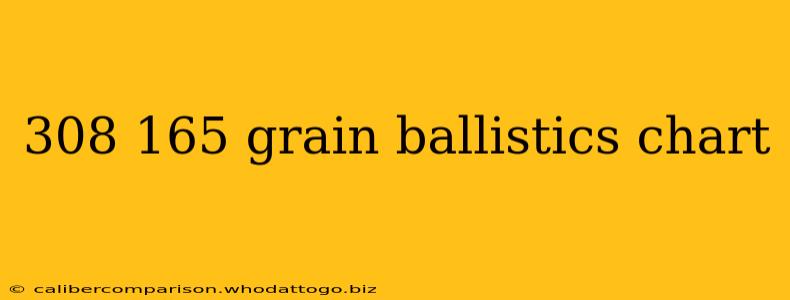The .308 Winchester, a versatile and popular cartridge, shines with its accuracy and stopping power across various applications. Choosing the right ammunition is crucial, and the 165-grain bullet is a frequently chosen weight for hunting medium-sized game and long-range target shooting. This guide delves into the ballistics of 165-grain .308 ammunition, providing a comprehensive understanding of its performance characteristics. We will explore different bullet types, their trajectory, and the factors influencing their ballistics.
Disclaimer: The information provided in this ballistic chart is for general knowledge and informational purposes only. Ballistic performance can vary significantly depending on factors such as barrel length, twist rate, altitude, temperature, and atmospheric conditions. Always consult the manufacturer's specifications for your specific ammunition and firearm before use. Safety should always be your top priority when handling firearms.
Understanding Ballistic Charts and Their Components
Before diving into the specifics of 165-grain .308 ballistics, let's define some key terms:
-
Muzzle Velocity (MV): The speed of the bullet as it leaves the barrel of the rifle. Measured in feet per second (fps) or meters per second (m/s).
-
Muzzle Energy (ME): The kinetic energy of the bullet at the muzzle. Measured in foot-pounds (ft-lbs) or joules (J).
-
Trajectory: The path the bullet follows in flight.
-
Ballistic Coefficient (BC): A measure of a bullet's ability to overcome air resistance. A higher BC means less air resistance and a flatter trajectory.
-
Zero Range: The distance at which the bullet's trajectory intersects the line of sight. Often used to adjust scope settings.
-
Drop: The amount the bullet falls below the line of sight at a given range.
165 Grain .308 Ballistics: A Comparative Look
Creating a precise ballistic chart requires specifying the exact ammunition being used. Manufacturers produce a wide variety of 165-grain .308 bullets, each with unique characteristics based on bullet design (boat tail, spitzer, etc.), material (lead core, full metal jacket, etc.), and manufacturer. This leads to differences in ballistic performance.
Example Scenarios (Illustrative – Not a definitive chart):
While we can't provide a single, universally accurate chart due to the variability mentioned above, we can illustrate typical performance ranges:
| Bullet Type | MV (fps) | ME (ft-lbs) | 100 Yard Drop (inches) (Approximate) | BC (G1) (Approximate) | Notes |
|---|---|---|---|---|---|
| FMJ Boat Tail | 2700 | 2700 | 8-12 | 0.450 | Good general-purpose round |
| Soft Point | 2650 | 2600 | 9-13 | 0.430 | Suitable for hunting medium-sized game |
| Match Grade Hollow Point | 2800 | 2850 | 6-10 | 0.500 | Designed for accuracy, often higher cost |
Note: The values above are approximate and serve only as an illustration. Always refer to the manufacturer's provided data for specific ammunition.
Factors Affecting .308 165 Grain Ballistics
Several factors significantly influence the ballistic performance of 165-grain .308 ammunition:
-
Barrel Length: Longer barrels generally produce higher muzzle velocity and energy.
-
Twist Rate: The rate of rifling in the barrel affects bullet stability. An incorrect twist rate can lead to poor accuracy.
-
Powder Charge: The amount of propellant used impacts both velocity and pressure.
-
Environmental Conditions: Temperature, air pressure, humidity, and wind all affect trajectory.
-
Bullet Construction: As mentioned earlier, bullet design and construction heavily impact ballistic performance, determining its BC and therefore its trajectory.
Conclusion
Choosing the right ammunition for your specific needs is crucial for accuracy and effectiveness. The 165-grain .308 bullet provides a strong balance of accuracy, energy, and range, making it suitable for various applications. However, understanding the factors influencing its ballistics and always referencing the manufacturer's data sheets are essential for safe and successful shooting. Always prioritize safety and responsible gun handling practices.

